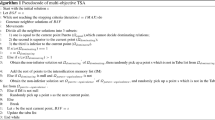Abstract
This paper presents a new method based on an immune-tabu hybrid algorithm to solve the thermal unit commitment (TUC) problem in power plant optimization. The mathematical model of the TUC problem is established by analyzing the generating units in modern power plants. A novel immune-tabu hybrid algorithm is proposed to solve this complex problem. In the algorithm, the objective function of the TUC problem is considered as an antigen and the solutions are considered as antibodies, which are determined by the affinity computation. The code length of an antibody is shortened by encoding the continuous operating time, and the optimum searching speed is improved. Each feasible individual in the immune algorithm (IA) is used as the initial solution of the tabu search (TS) algorithm after certain generations of IA iteration. As examples, the proposed method has been applied to several thermal unit systems for a period of 24 h. The computation results demonstrate the good global optimum searching performance of the proposed immune-tabu hybrid algorithm. The presented algorithm can also be used to solve other optimization problems in fields such as the chemical industry and the power industry.
Similar content being viewed by others
References
Arroyo, J.M., Conejo, A.J., 2002. A parallel repair genetic algorithm to solve the unit commitment problem. IEEE Trans. Power Syst., 17(4):1216–1224. [doi:10.1109/TPWRS.2002.804953]
Bard, J.F., 1988. Short-term scheduling of the thermal-electric generators using Lagrangian relation. Oper. Res., 36(5):756–766. [doi:10.1287/opre.36.5.756]
Cai, C.H., Cai, Y.Y., 1997. Optimization of unit commitment by genetic algorithm. Power Syst. Technol., 21(1):44–47, 51.
Chen, S.L., Zhan, T.S., Tsay, M.T., 2006. Generation expansion planning of the utility with refined immune algorithm. Electr. Power Syst. Res., 76(4):251–258. [doi:10.1016/j.epsr.2005.06.005]
Cheng, C.P., Liu, C.W., Liu, C.C., 2000. Unit commitment by Lagrangian relaxation and genetic algorithms. IEEE Trans. Power Syst., 15(2):707–714. [doi:10.1109/59.867163]
Dieu, V.N., Ongsakul, W., 2007. Improved merit order and enhanced augmented Lagrange Hopfield network for unit commitment. IET Gener. Trans. Distrib., 1(4):548–556. [doi:10.1049/iet-gtd:20060321]
Dillon, T.S., 1978. Integer programming approach to the problem of unit commitment with probabilistic reserver determination. IEEE Tran. Power Appar. Syst., 97(6):2154–2166. [doi:10.1109/TPAS.1978.354719]
El-Amin, I., Duffuaa, S., Abbas, M., 2000. A tabu search algorithm for maintenance scheduling of generating units. Electr. Power Syst. Res., 54(2):91–99. [doi:10.1016/S0378-7796(99)00079-6]
Fan, H., Wei, H., 2004. Improved genetic algorithm and its application in unit commitment optimization. Proc. EPSA, 16(4):46–49, 63.
Fan, W., Guan, X.H., Zhai, Q.Z., 2002. A new method for unit commitment with ramping constraints. Electr. Power Syst. Res., 62(3):215–224. [doi:10.1016/S0378-7796(02)00043-3]
Gao, J., 2001. The application of the immune algorithm for power network planning. Syst. Eng.-Theory & Pract., 5:119–123.
Han, X.S., Liu, Z., 1994. Optimal unit commitment considering unit’s ramp-rate limits. J. Power Syst. Technol., 16:11–16.
Huang, S.J., 1999. Enhancement of thermal unit commitment using immune algorithms based optimization approaches. Int. J. Electr. Power Energy Syst., 21(4):245–252. [doi:10.1016/S0142-0615(98)00050-7]
Juste, K.A., Kita, H., Tanaka, E., Hasegawa, J., 1999. An evolutionary programming solution to the unit commitment problem. IEEE Trans. Power Syst., 14(4):1452–1459. [doi:10.1109/59.801925]
Kazarlis, S.A., Bakirtzis, A.G., Petridis, V., 1996. A genetic algorithm solution to the unit commitment problem. IEEE Trans. Power Syst., 11(1):83–92. [doi:10.1109/59.485989]
Kothari, D.P., Ahmad, A., 1995. An expert system approach to the unit commitment problem. Energy Conv. Manag., 36(4):257–261. [doi:10.1016/0196-8904(94)00075-B]
Li, W., Sheng, D.R., Chen, J.H., Yuan, Z.F., Cen, K.F., 2006. A New Method Based on Immune Algorithm to Solve the Unit Commitment Problem. In: Knowledge Enterprise: Intelligent Strategies in Product Design, Manufacturing, and Management. Springer, Boston, 207:840–846. [doi:10.1007/0-387-34403-9_117]
Liao, G.C., 2006. Short-term thermal generation scheduling using improved immune algorithm. Electr. Power Syst. Res., 76(5):360–373. [doi:10.1016/j.epsr.2005.06.009]
Mantawy, A.H., 2004. A genetic algorithm solution to a new fuzzy unit commitment mode. Electr. Power Syst. Res., 72(2):171–178. [doi:10.1016/j.epsr.2004.04.003]
Mantawy, A.H., Abdel-Magid, Y.L., Selim, S.Z., 1998. Unit commitment by tabu search. IEE Proc.-Gener. Transm. Distrib., 145(1):55–64. [doi:10.1049/ip-gtd:19981681]
Mantawy, A.H., Abdel-Magid, Y.L., Selim, S.Z., 1999. A new genetic-based tabu search algorithm for unit commitment problem. Electr. Power Syst. Res., 49(2):71–78. [doi:10.1016/S0378-7796(98)00045-5]
Ongsakul, W., Petcharaks, N., 2004. Unit commitment by enhanced adaptive Lagrangian relaxation. IEEE Trans. Power Syst., 19(1):620–628. [doi:10.1109/TPWRS.2003.820707]
Ouyang, Z., Shahidehpour, S.M., 1992. A hybrid artificial neural network-dynamic programming approach to unit commitment. IEEE Trans. Power Syst., 7(1):236–242. [doi:10.1109/59.141709]
Pang, C.K., Sheblé, G.B., Albuyeh, F., 1981. Evaluation of dynamic programming based methods and multiple area representation for thermal unit commitments. IEEE Trans. Power Appar. Syst., 100(3):1212–1218. [doi:10.1109/TPAS.1981.316592]
Pei, J.Y., Lai, Y.F., Chen, P., Ji, C.M., 2001. Modified genetic algorithm for optimizing combination of units. Eng. J. Wuhan Univ., 34:72–76 (in Chinese).
Saber, A.Y., Senjyu, T., Miyagi, T., Urasaki, N., Funabashi, T., 2007. Two-fold simulated annealing approach to unit commitment scheduling. Electr. Power Compon. Syst., 35(3):337–357. [doi:10.1080/15325000600978783]
Senjyu, T., Yamashiro, H., Uezato, K., Funabashi, T., 2002. A Unit Commitment Problem by Using Genetic Algorithm Based on Characteristic Classification. IEEE Power Engineering Society Winter Meeting, 1:58–63. [doi:10.1109/PESW.2002.984954]
Shi, Q., Li, C.H., Wang, J.W., 2002. The application of genetic algorithm to short-term generation scheduling. Proc. EPSA, 14:56–59.
Sun, Y.Z., Wei, W., 2002. Solution of optimal power flow problem based on artificial immune algorithm. Autom. Electr. Power Syst., 26:30–34.
Swarup, K.S., Yamashiro, S., 2003. A genetic algorithm approach to generator unit commitment. Int. J. Electr. Power Energy Syst., 25(9):679–687. [doi:10.1016/S0142-0615(03)00003-6]
Victoire, T.A., Jeyakumar, A.E., 2006. A tabu search based hybrid optimization approach for a fuzzy modelled unit commitment problem. Electr. Power Syst. Res., 76(6–7):413–425. [doi:10.1016/j.epsr.2005.08.004]
Yang, P.C., Yang, H.T., Huang, C.L., 1996. Solving the unit commitment problem with a genetic algorithm through a constraint satisfaction technique. Electr. Power Syst. Res., 37(1):55–65. [doi:10.1016/0378-7796(96)01036-X]
Zhuang, F., Galiana, F.D., 1990. Unit commitment by simulated annealing. IEEE Trans. Power Syst., 5(1):311–318. [doi:10.1109/59.49122]
Author information
Authors and Affiliations
Corresponding author
Additional information
Project partially supported by the Lamar Research Enhancement Grant and the National Science Foundation Grant (No. DUE-0737173) to Dr. W. Zhu at Lamar University
Rights and permissions
About this article
Cite this article
Li, W., Peng, Hy., Zhu, Wh. et al. An immune-tabu hybrid algorithm for thermal unit commitment of electric power systems. J. Zhejiang Univ. Sci. A 10, 877–889 (2009). https://doi.org/10.1631/jzus.A0820607
Received:
Accepted:
Published:
Issue Date:
DOI: https://doi.org/10.1631/jzus.A0820607




